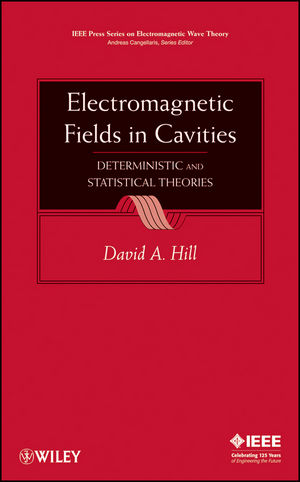Electromagnetic Fields in Cavities: Deterministic and Statistical TheoriesISBN: 978-0-470-46590-5
Hardcover
296 pages
October 2009, Wiley-IEEE Press
 This is a Print-on-Demand title. It will be printed specifically to fill your order. Please allow an additional 10-15 days delivery time. The book is not returnable.
|
||||||
PART I. DETERMINISTIC THEORY.
1. Introduction.
1.1 Maxwell’s Equations.
1.2 Empty Cavity Modes.
1.3 Wall Losses.
1.4 Cavity Excitation.
1.5 Perturbation Theories.
Problems.
2. Rectangular Cavity.
2.1 Resonant Modes.
2.2 Wall Losses and Cavity Q.
2.3 Dyadic Green’s Functions.
Problems.
3. Circular Cylindrical Cavity.
3.1 Resonant Modes.
3.2 Wall Losses and Cavity Q.
3.3 Dyadic Green’s Functions.
Problems.
4. Spherical Cavity.
4.1 Resonant Modes.
4.2 Wall Losses and Cavity Q.
4.3 Dyadic Green’s Functions.
4.4 Schumann Resonances in the Earth-Ionosphere Cavity.
Problems.
PART II. STATISTICAL THEORIES FOR ELECTRICALLY LARGE CAVITIES.
5. Motivation for Statistical Approaches.
5.1 Lack of Detailed Information.
5.2 Sensitivity of Fields to Cavity Geometry and Excitation.
5.3 Interpretation of Results.
Problems.
6. Probability Fundamentals.
6.1 Introduction.
6.2 Probability Density Function.
6.3 Common Probability Density Functions.
6.4 Cumulative Distribution Function.
6.5 Methods for Determining Probability Density Functions.
Problems.
7. Reverberation Chambers.
7.1 Plane-Wave Integral Representation of Fields.
7.2 Ideal Statistical Properties of Electric and Magnetic Fields.
7.3 Probability Density Functions for the Fields.
7.4 Spatial Correlation Functions of Fields and Energy Density.
7.5 Antenna or Test-Object Response.
7.6 Loss Mechanisms and Chamber Q.
7.7 Reciprocity and Radiated Emissions.
7.8 Boundary Fields.
7.9 Enhanced Backscatter at the Transmitting Antenna.
Problems.
8. Aperture Excitation of Electrically Large, Lossy Cavities.
8.1 Aperture Excitation.
8.2 Power Balance.
8.3 Experimental Results for SE.
Problems.
9. Extensions to the Uniform-Field Model.
9.1 Frequency Stirring.
9.2 Unstirred Energy.
9.3 Alternative Probability Density Function.
Problems.
10. Further Applications of Reverberation Chambers.
10.1 Nested Chambers for Shielding Effectiveness Measurements.
10.2 Evaluation of Shielded Enclosures.
10.3 Measurement of Antenna Efficiency.
10.4 Measurement of Absorption Cross Section.
Problems.
11. Indoor Wireless Propagation.
11.1 General Considerations.
11.2 Path Loss Models.
11.3 Temporal Characteristics.
11.4 Angle of Arrival.
11.5 Reverberation Chamber Simulation.
Problems.
APPENDIX A. VECTOR ANALYSIS.
APPENDIX B. ASSOCIATED LEGENDRE FUNCTIONS.
APPENDIX C. SPHERICAL BESSEL FUNCTIONS.
APPENDIX D. THE ROLE OF CHAOS IN CAVITY FIELDS.
APPENDIX E. SHORT ELECTRIC DIPOLE RESPONSE.
APPENDIX F. SMALL LOOP ANTENNA RESPONSE.
APPENDIX G. RAY THEORY FOR CHAMBER ANALYSIS.
APPENDIX H. ABSORPTION BY A HOMOGENEOUS SPHERE.
APPENDIX I. TRANSMISSION CROSS SECTION OF A SMALL CIRCULAR APERTURE.
APPENDIX J. SCALING.
REFERENCES.
INDEX.



